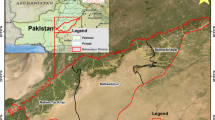Abstract
Desertification process as a great problem affects most of the countries in the world. This process has a high rate in arid and semiarid areas. Today, human societies are encountering the desertification phenomenon as a serious problem which causes various irreparable damages to economic and social sectors. In order to assess desertification results in production of different regional models for their application in another region the indices should be re-investigated and adjusted to local conditions. Several models have been developed for desertification evaluation. The present study, attempts to assess quantitatively the desertification process has in an area located at Sistan plain of Iran (Niatak region as a case study) by using Modified MEDALUS method. The obtained results indicated that of the whole studied region (comprising 4819.6 acres), 2651.56 acres (55%) are located in medium desertification intensity class, 1269.48 acres (26.34%) are positioned in severe desertification intensity class, and 898.54 acres (18.64%) are placed in vary severe desertification intensity class.
Similar content being viewed by others
References
Afifi A, Gad A, Refat A, 2010. Use of GIS and remote sensing for environmental sensitivity assessment of north coastal part, Egypt. Journal of American Science, 2010, 6(11).
Ahmadi H, 2006. Applied Geomorphology 2. 3rd ed. Tehran University Press, 706.
Ahmadi H, Abrisham E, Ekhtesasi M R et al., 2006. Assessment and mapping of desertification using MICD and ICD model in FakhrAbad, Mehriz region. Desert Journal, 10(1): 165–187.
Batterbury S P J, Warren A, 2001. Desertification. In: Smelser N, Baltes P (eds.). International Encyclopædia of the Social and Behavioral Sciences. Elsevier Press, 3526–3529.
Ekhtesasi M R, Mohajeri S, 1995. Classification method and type of desertification intensity for lands in Iran, Supervising Engineers in Iran Society: Sharing Solutions. The 2nd National of Desertification and Control Desertification Conference, Kerman University, Iran.14.
Fuzuni L, 2008. Investigating the current statues of desertification in the Sistan plain with modified MEDALUS method with emphasize on water and wind erosion [D]. Zabol University, 131.
Geeson N A, Brandt C J, Thornes J B, 2002. Mediterranean Desertification: A Mosaic of Processes and Responses. Wiley.
Ghasemi M, 2007. Investigating the benchmark and indices of desertification with emphasize on water and soil to estimate and prepare desertification map (case study; Zabol) [D]. College of Natural Resources, Tehran University, 147.
God A, Lotfy I, 2008. Use of remote sensing and GIS in mapping the environmental sensitivity areas for desertification of Egyptian territory. Earth Discussion, 3: 41–85.
Goia A N, 2001. Investigating the effective factors of desertification in the Hussein Abad Mir Mast plain of Qom and presentation of a regional model [D]. Tehran University, 132.
Hosseini S M, 2008. Classification of desertification intensity in Niatak-Sistan region, Iran, by ICD model [D]. Zabol University, 127.
Kosmas C, Kirkby M, Geeson N, 1999. The MEDALUS project. Mediterranean Desertification and Land Use. Manual on key indicators of desertification and Mapping Environmentally Sensitive Areas to Desertification. European Commission, Brussels. EUR 18882.
Kosmas C, Ferrara A, Briasouli H et al., 1999. Methodology for mapping Environmentally Sensitive Areas (ESAs) to desertification. In: Kosmas C, Kirkby M, Geeson N. The Medalus Project Mediterranean Desertification and Land Use. Manual on Key Indicators of Dsertification and Mapping Environmentally Sensitive Areas to Desertification. European Union 18882: 31–47.
Ladisa G, Todofvica M, Trisorio-Liuzzi G, 2002. Characterization of area sensitive to desertification in southern Italy. Proc. of the 2nd. Conf. on New Trend in Water and Environmental Engineering for Safety and Life. Eco-compatible Solution for Aquatic Environmental, Capri, Italy, 2–14.
Sepehr A, Ekhtesasi M R, 2008. Application of GIS and remote sensing in assessment of desertification. Iran’s Natural Resources, Vol.61: 537–554.
Tucker C J, Dregne H E, Newcomb W W, 1991. Expansion and contraction of the Sahara Desert from 1980 to 1990. Science, 253: 299–301.
UNEP, 2002. Sistan Oasis Parched by Drought. Complied by UNEP/DEWP/GRID-Geneva, July, 11–21.
Zehtabian G R, Amiraslani F, Khosravi H, 2006. The reapplication of MEDALUS methodology in Kashan desertified region, Iran. 14th International Soil Conservation Organization Conference. Water Management and Soil Conservation in Semi-arid Environments. Marrakech, Morocco, May 14–19, 2006 (ISCO 2006).
Author information
Authors and Affiliations
Corresponding author
Additional information
Author: Seyed Mahmood Hosseini, Master, specialized in desertification.
Rights and permissions
About this article
Cite this article
Hosseini, S.M., Sadrafshari, S. & Fayzolahpour, M. Desertification hazard zoning in Sistan Region, Iran. J. Geogr. Sci. 22, 885–894 (2012). https://doi.org/10.1007/s11442-012-0970-x
Received:
Accepted:
Published:
Issue Date:
DOI: https://doi.org/10.1007/s11442-012-0970-x




